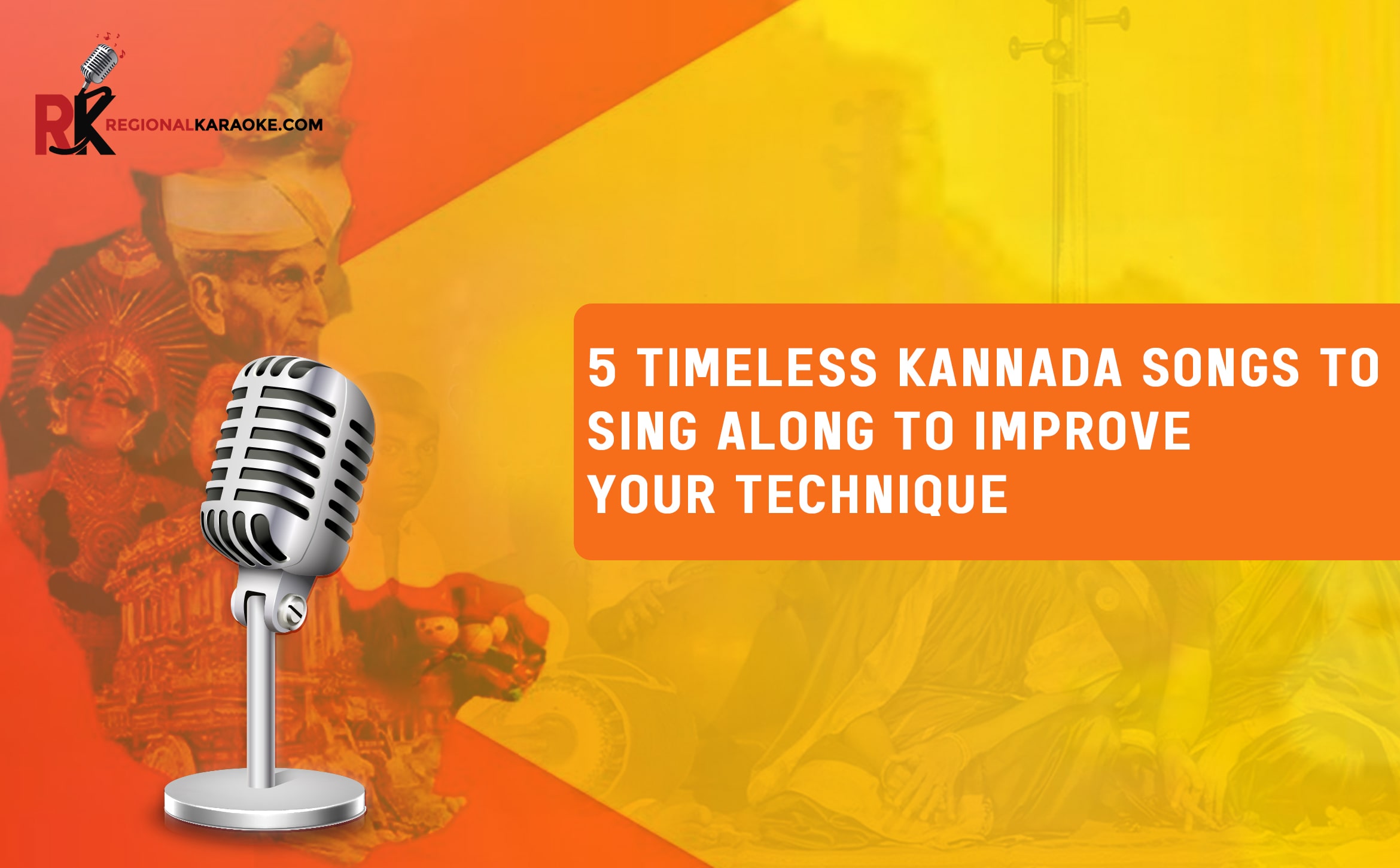Christmas Store-Wide Karaoke Sale | 40% Off | USE COUPON CODE - RKXMAS40
The Impact of Classical and Film Songs on Kannada Music Culture

- The Influence of Classical Music on Kannada Music Culture
- Historical Timeline of Kannada Music Evolution
- The Emergence and Evolution of Kannada Film Songs
- Influence of Bhavageethe and Sugama Sangeetha
- The Symbiosis Between Classical and Film Music
- The Cultural and Social Impact
- Impact of Legendary Kannada Singers
- Regional and Folk Influences in Kannada Film Music
- Comparison with Other South Indian Music Cultures
- Modern Trends in Kannada Film Music
- Role of Music Competitions & TV Shows
- Comparison with Other South Indian Music Cultures
- Impact of Streaming Platforms on Kannada Music & Karaoke
- Karaoke as a Tool for Learning Kannada Language
- The Role of Karaoke in Preserving Kannada Music Culture
- Classical Influence on Kannada Karaoke Songs
- Evolution of Kannada Film Songs in the Karaoke Industry
- Best Kannada Karaoke Songs for Classical and Film Music Lovers
- Conclusion
Kannada music culture is a rich and evolving tradition that various musical influences have shaped over centuries. Classical music and film songs have played pivotal roles in defining Karnataka's musical identity. While classical music has provided a foundation for melodic structures, intricate compositions, and refined aesthetics, film songs have popularized these elements and taken them to a mass audience. This interplay has created a dynamic musical landscape that thrives and evolves.
The Influence of Classical Music on Kannada Music Culture
Classical music, particularly Carnatic music, has profoundly influenced Kannada music culture. Karnataka has been home to legendary composers and musicians who have significantly contributed to the Carnatic tradition. The compositions of Purandara Dasa, regarded as the father of Carnatic music, laid the groundwork for the systematization of the genre. His kritis and padas, often composed in Kannada, continue to be revered and performed by musicians today.
Carnatic music, including ragas, talas, and gamakas, has provided Kannada music culture with a strong theoretical framework. This framework influences classical compositions, folk music, and contemporary music. The intricate nature of classical compositions, the emphasis on swara (notes), and the improvisational aspects have shaped how Kannada musicians approach melody and rhythm.
Several renowned classical musicians from Karnataka, such as M. S. Subbulakshmi (who had strong roots in Kannada heritage), Bhimsen Joshi, and Dr. M. Balamuralikrishna, have played crucial roles in promoting the classical tradition while incorporating Kannada lyrical and thematic elements. In particular, the Mysore and Dharwad regions have been hubs for classical music, producing legendary musicians who have contributed to the global appreciation of Carnatic and Hindustani music.
Historical Timeline of Kannada Music Evolution
Tracing Kannada music’s evolution over time can provide valuable insights into its journey:
- Pre-16th Century: Dominated by devotional music from Haridasa composers.
- 16th-19th Century: Classical music flourished under the patronage of Mysore kings.
- 1930s-1950s: Early Kannada film music had a heavy Carnatic influence.
- 1960s-1980s: Folk and light music influences started blending with film songs
- 1990s-Present: Fusion of various global musical styles with Kannada film music, including digital advancements.
The Emergence and Evolution of Kannada Film Songs
With the advent of cinema, film songs emerged as a powerful medium to reach a wider audience. Unlike classical music, which was often restricted to connoisseurs and elite gatherings, film songs became accessible to people from all walks of life. The Kannada film industry, also known as Sandalwood, saw a fusion of classical elements with contemporary styles to create music that resonated with the masses.
The early years of Kannada film music were heavily influenced by Carnatic and Hindustani music. Legendary composers such as P. Kalinga Rao, R. Sudarshanam, and G. K. Venkatesh infused their compositions with classical ragas, ensuring film music retained its artistic depth while appealing to mainstream audiences. Songs like "Baare Baare Chandada Cheluvina Taare" and "Naadamaya Ee Lokavella" exhibit the seamless integration of classical influences within film music.
As time progressed, Kannada film music diversified, incorporating elements of folk, Western, and fusion styles. The 1970s and 1980s saw composers like Rajan-Nagendra, Ilaiyaraaja, and Hamsalekha experiment with orchestration and melody, bringing a fresh and contemporary appeal to Kannada film songs. Despite these innovations, many compositions continued to be rooted in classical structures, ensuring a blend of tradition and modernity.
Influence of Bhavageethe and Sugama Sangeetha
Apart from film and classical music, Bhavageethe and Sugama Sangeetha have played a significant role in Kannada music culture. These forms blend poetic lyrics with melodic compositions, focusing on deep emotions and literary richness. Several Kannada karaoke enthusiasts prefer Bhavageethe for its expressive nature, making it a popular choice in cultural events.
The Symbiosis Between Classical and Film Music
One of the defining aspects of Kannada music culture is the symbiotic relationship between classical and film music. Many legendary playback singers in the Kannada film industry, such as Dr. Rajkumar, P. B. Sreenivas, S. Janaki, and K. J. Yesudas, were trained in classical music, which gave them a strong foundation in voice modulation, swara control, and emotive expression.
Similarly, Kannada film songs have often served as an entry point for audiences to appreciate classical music. Songs based on classical ragas, such as "Anisuthide Yaako Indu" from Mungaru Male (based on Kalyani raga) and "Naguva Nayana" from Pallavi Anu Pallavi (based on Suddha Dhanyasi raga), have subtly introduced listeners to the nuances of classical music without requiring formal training.
Moreover, classical musicians have also found a place in the Kannada film industry, composing or lending their expertise to film scores. Artists like M. Balamuralikrishna and L. Subramaniam have contributed to Kannada film music, further strengthening the bond between these two realms.
The Cultural and Social Impact
The impact of classical and film songs on Kannada music culture extends beyond music—it has shaped linguistic, cultural, and social identities. With its rich lyrical compositions in Kannada, classical music has preserved the language’s poetic beauty. Works of great poets such as Kuvempu, D. R. Bendre, and Da. Ra. Bendre has been adapted into musical compositions, keeping Kannada's literary heritage alive.
On the other hand, film music has played a crucial role in social messaging, reflecting themes of love, patriotism, devotion, and societal issues. Songs like "Huttidare Kannada Nadalli Huttabeku" have instilled a sense of regional pride, while devotional songs in films have reinforced Karnataka's spiritual and religious fabric.
Additionally, Kannada music culture has embraced digital transformation. Classical and film songs now reach global audiences through streaming platforms and YouTube. This accessibility has led to the resurgence of classical music appreciation among younger generations, who are discovering the roots of their favorite film melodies in classical ragas.
Impact of Legendary Kannada Singers
Legendary singers such as Dr. Rajkumar, P. B. Sreenivas, S. Janaki, and S. P. Balasubrahmanyam have shaped Kannada music. Their unique vocal styles and emotive renditions have left an indelible mark on Kannada film and classical music. Their contributions continue to inspire new generations of artists and music lovers.
Regional and Folk Influences in Kannada Film Music
The diverse folk traditions of Karnataka, such as Janapada songs and Bhavageethe, have heavily influenced Kannada film music. Folk music's rhythmic and lyrical richness has been integrated into movie compositions, adding a unique regional flavor.
Comparison with Other South Indian Music Cultures
Kannada music shares similarities with Tamil, Telugu, and Malayalam music, especially in terms of classical influences. However, it has distinct characteristics regarding lyrical style, folk influences, and melodic structures. Understanding these differences helps appreciate Kannada music's uniqueness within the broader South Indian music scene.
Modern Trends in Kannada Film Music
The digital era has brought independent artists, fusion music, and electronic elements into Kannada music. Streaming platforms and digital production tools have made Kannada songs more experimental while retaining classical influences.
Role of Music Competitions & TV Shows
Reality shows like Sa Re Ga Ma Pa and Kannada Kogile have been significant in discovering new talent and keeping classical and film music relevant. These platforms allow aspiring singers to showcase their talent and revive interest in Kannada music.
Comparison with Other South Indian Music Cultures
Kannada music shares similarities with Tamil, Telugu, and Malayalam music, especially in terms of classical influences. However, it has distinct characteristics regarding lyrical style, folk influences, and melodic structures. Understanding these differences helps appreciate Kannada music's uniqueness within the broader South Indian music scene.
Impact of Streaming Platforms on Kannada Music & Karaoke
Digital platforms such as YouTube, Spotify, and Kannada karaoke websites and apps have significantly contributed to the accessibility of Kannada music. Streaming services allow users to explore Kannada music beyond traditional radio and television, whether it's classical songs, film hits, or folk renditions. Additionally, karaoke apps and websites make it easier for enthusiasts to practice and perform Kannada songs anytime.
Karaoke as a Tool for Learning Kannada Language
Karaoke is an engaging way for non-native speakers and younger generations to connect with Kannada language and music. Singing Kannada songs through karaoke helps improve pronunciation, linguistic familiarity, and cultural appreciation.
The Role of Karaoke in Preserving Kannada Music Culture
Karaoke has emerged as an essential tool for preserving and promoting Kannada music culture. With the increasing availability of Karaoke tracks, music enthusiasts can practice and perform Kannada songs, keeping traditional melodies alive. Karaoke allows trained singers and casual enthusiasts to engage with classical and film songs, ensuring their continued popularity.
Singing Kannada classical or film songs through Karaoke helps individuals understand the nuances of ragas, rhythm, and lyrical beauty. It also introduces younger generations to Kannada music, making it more interactive and engaging.
Classical Influence on Kannada Karaoke Songs
Many Kannada film songs based on classical ragas have become popular in Karaoke. These songs provide a perfect platform for singers to practice classical techniques while enjoying film music. Some of the best examples of Kannada karaoke songs include:
- "Naadamaya Ee Lokavella" (raga-based classical song from Kannada cinema)
- "Anisuthide Yaako Indu" (melodious song with classical undertones)
- "Teredide Mane" (a timeless classic with deep ragas)
Practicing these songs in Karaoke format helps singers develop control over pitch, rhythm, and expression, making it an excellent tool for vocal training.
Evolution of Kannada Film Songs in the Karaoke Industry
With the rising popularity of Karaoke, Kannada film songs have become more accessible for fans to sing and enjoy. Earlier, only old classical-based songs were available in Karaoke, but today, a vast collection of modern Kannada songs is also available.
While traditional classical-based songs require a strong understanding of musical techniques, contemporary Kannada film songs are more straightforward for beginners to sing. However, both styles have charm, and Karaoke provides a way to explore them equally.
Best Kannada Karaoke Songs for Classical and Film Music Lovers
Here are some Kannada karaoke songs to sing at your next event:
- "Jotheyali Jothe Jotheyali" – A beautiful song with a classical touch
- "Nee Amruthadhare" – A soulful melody perfect for Karaoke
- "Teredide Mane" – A song deeply rooted in traditional music
- "Baanallu Neene" – A soothing song with classical influences
These songs are excellent choices for karaoke enthusiasts who want to experience the beauty of Kannada music, especially those looking for the perfect Kannada karaoke songs for events.
Conclusion
The impact of classical and film songs on Kannada music culture is profound and enduring. Classical music has provided a solid foundation for technical excellence, while film songs have democratized musical appreciation, making melodies more accessible to a broad audience. The interplay between these two musical forms has created a unique and evolving Kannada music culture that respects tradition while embracing modernity. The relationship between classical and film songs will remain integral to its identity. Whether through the sophisticated ragas of Carnatic music or the emotional depth of film melodies, Kannada music culture will continue to thrive, reflecting Karnataka's artistic and cultural spirit






